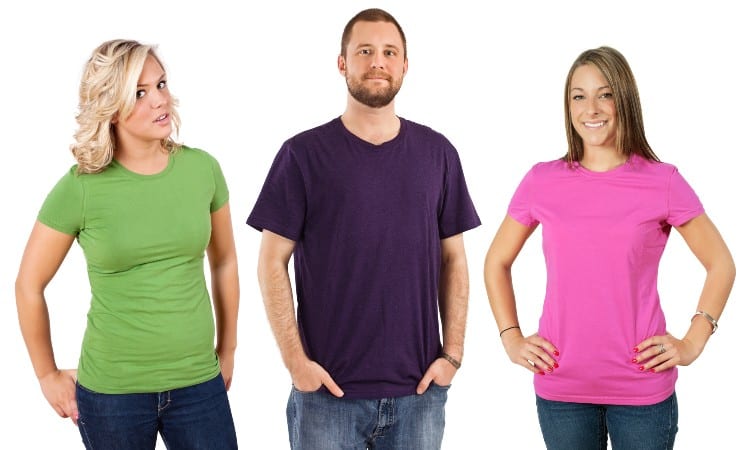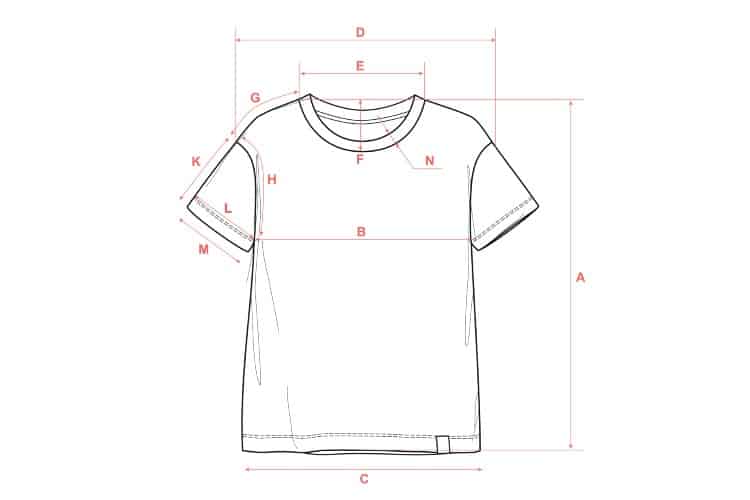All around the world, people wear t-shirts to celebrate a sports team, share a funny saying, or just relax in comfort! But getting a tee that fits you perfectly is not always easy. Fortunately, you can learn how to measure t-shirt size in a few simple steps!
The best way to measure for t-shirt size is to determine the circumference of the shoulders and chest. Length measurements such as sleeve length and shoulder to hem length will also help. Sometimes, shirt sellers use height and weight instead of specific measurements to determine shirt sizing.
In this article, you will learn how t-shirt sizing works. You will learn how to measure yourself or your shirt to determine the right size. Finally, you will find tips on how to know if your tee fits you or not!

Quick Navigation
How Does T-Shirt Sizing Work?
T-shirt sizing uses a generic small, medium, and large system, but you can find a lot of variations within this simple metric. Usually, sizes increase by about one inch in the chest circumference and ½ inch in the shoulder width. So a medium tee might have a chest measurement of 40 inches, and a large would have a chest measurement of 41 inches.
That said, the first important thing to know is that there is no standardized measurement used to determine t-shirt sizes. This means that a men’s medium tee from Gildan will have slightly different measurements than a men’s medium from another brand, such as Fruit of the Loom.
T-shirt sizes also vary a little based on the style of the shirt. Most brands offer style options such as a fitted tee, muscle tee, athletic tee, or regular tee. If you compare a fitted vs a regular medium tee from the same brand, you will once again find slightly different measurements.
Of course, you also want to keep in mind that women’s t-shirts often have a more curved shape with concave side seams. This can lead to much smaller measurements for women’s fit tees than for regular fit tees.
With so many variations in the shapes and brands of t-shirts available today, the best way to understand t-shirt sizing is to use sizing charts. Every brand or seller should provide a chart that lists the individual measurements for key areas of the t-shirt, such as the chest circumference and the sleeve length.
T-Shirt Measurements

T-shirt manufacturers use chest, shoulders, sleeve length, and body width measurements to determine the size of a shirt. Depending on the style of the shirt, the manufacturer may list other key measurements as well, such as the waist circumference and the shoulder width.
Chest
The chest measurement on a t-shirt describes the circumference of the shirt at a point just below the armpit. For pretty much any t-shirt style or brand, the chest and shoulder measurements determine the size of the shirt as they are the largest areas of the shirt.
The easy way to find the chest measurement on a shirt is to spread it out flat and measure across the shirt from one side seam to the other at the armpits. Then double this measurement to include both the front and back of the shirt.
Some brands use a point one inch below the armpits to denote the chest, so make sure you read the fine print on a sizing chart before you do a chest measurement on yourself!
Shoulders
Shoulder width also plays a key role in determining the size of a tee, especially for men’s shirts. For most men, the shoulders form the broadest part of the body, so it makes sense to use this as the starting point to determine a shirt size!
Most (though not all) t-shirt sellers use a shoulder width measurement on a shirt. This means the distance from the end of one shoulder to the other. If the shirt has a sleeve seam circling the armhole, you can use this seam at the top of the shoulder as your starting point.
Other sellers may use a neck-to-shoulder measurement instead. This measures from the base of the neck or the shirt’s collar to the end of the shoulder.
Length
To measure the length of a t-shirt, start at the shoulder seam where it meets the collar, and measure in a straight line down to the hem. This will tell you how long the shirt is!
Though this is an approximation, many brands increase shirt length by about three inches per size for men’s shirts. So a medium tee might have a length of 44 inches, and a large in the same brand would have a length of 47 inches. For women’s shirts, you will usually find less of an increase, often just one or two inches per size.
Sleeve Length
The sleeve length on a t-shirt reaches from the hem of the sleeve to the shoulder seam. You can use this measurement on a long sleeve or short sleeve tee.
In some cases, especially if you plan to buy or sell custom tees, you may also want to consider other sleeve measurements. These include the armhole circumference, which tells you how wide the circle at the top of the sleeve is, and the hem style. Most t-shirts use a simple double-stitched hem style on the sleeve, but you can find variations on custom shirts.
Body Width
A body width on a t-shirt could mean the chest measurement or the waist measurement. Most of the time, a brand that sells fitted tee shirts or women’s tees will offer a waist measurement as well as a chest and shoulder measurement. This matters for fitted shirts in particular because they narrow at the waist. Some brands may call this “stomach fit” or “navel fit” instead.
You can find pretty big differences in the waist measurement within one size depending on the style of the shirt. For example, a regular-cut medium tee might have a waist measurement of 34 inches, but a medium athletic or more fitted cut in the same shirt could have a waist measurement an inch less than that!
However, many t-shirt size charts will not include a body width or waist measurement. Sellers generally only list this when it makes a difference in the fit of the shirt, such as with a women’s cut or a more fitted style of men’s tees.
How to Measure T-Shirt Size: 5 Methods

Now that you know how manufacturers measure t-shirts for sizing, you can quickly learn how to measure yourself for a t-shirt!
For Men
The most important t-shirt sizing measurements for men are the chest and shoulders. Follow these simple steps to get your measurements:
- Start by standing with a relaxed posture in front of a mirror. Do not flex or hold a deep breath during these measurements.
- Use a flexible tape measure to circle the widest portion of your chest, just below your armpits. Keep an eye on the mirror to make sure the tape remains level as it circles your upper back.
- Pull the tape tightly enough that you can’t slide a finger under it, but don’t let it dig into your skin.
- Write down this measurement.
- Next, measure your shoulder width by stretching the tape from the end of one shoulder, across your upper back, to the end of the other shoulder. It may help to get a friend to hold the tape for you.
- Finally, it’s also a good idea to measure yourself for t-shirt length. Not every seller lists this for men’s tees in a sizing chart, but knowing how long or short the shirt will fall on you can often help you get a good fit!
- To measure yourself for t-shirt length, place the short end of the tape at the base of your neck, right where the shoulder seam of a shirt would fall.
- Let the rest of the tape fall straight down your front.
- Pinch the tape at a point below your waist where you would like the hem of the shirt to end.
- Note down this measurement.
For Women
The two most important measurements for women’s t-shirts are the bust and waist measurements. You may also want to take a shirt length measurement, especially if you like your tees to fall to a certain point on your body.
- You should take these measurements wearing the kind of bra you plan to wear under your t-shirts for the best results.
- Stand with your feet flat on the floor in a relaxed posture, with your shoulders and back fairly straight.
- For your bust measurement, locate the fullest area of your bust and circle your torso at this point. Use a mirror to make sure the tape measure remains level as it crosses your upper back.
- Bring the tape all the way around to meet in front of you. Pull it tight, but not so tight that it indents your skin at any point.
- Write down your bust measurement.
- Next, find the most narrow part of your torso to locate your waist. Typically, this point falls about an inch below your navel.
- Circle your natural waistline with the flexible tape. Once again, use the mirror to make sure it forms a level circle all the way around your body.
- Write down your waist measurement.
- Finally, you may also need a shirt length measurement. This works best while wearing a tee that fits you well.
- Find the shoulder seam on the shirt. Place the short end of the tape at the point where the shoulder seam meets the collar of the shirt.
- Now use your other hand to smooth the tape down your front, over your bust, and dip in at your waist until you reach the hem of the shirt.
- Write down this number.
Measure Shirt
Another handy way to find your t-shirt measurements is to measure a tee that fits you the way you like. This works especially well if you want to get measurements of a fitted shirt or a muscle shirt with just the right size.
To measure a t-shirt:
- Spread the shirt flat on a hard surface like a floor or a kitchen table.
- Start by measuring the chest width. For this, stretch a tape measure from one armpit and straight across the shirt to the other armpit. Double this number and write it down.
- To measure the shoulder width, locate the point where the armhole sleeve meets the shoulder seam (or the end of the shoulder in the shirt). Reach the tape from this point on one side of the shirt to the same point on the other side. You do not need to double this number.
- In some cases, you may also want a neck-to-shoulder measurement. For this, measure from the collar down the shoulder seam to the point where the shoulder seam stops at the sleeve.
- For the waist, find the narrowest point of the shirt above the hem. Measure from side seam to side seam straight across the shirt at this point. Double your measurement to include both the front and back of the waistline.
- For the length of the tee, measure from the highest section of the shoulder–usually right at the collar–all the way down to the hem in a straight line.
In Inches
Unlike dress shirts, t-shirts typically do not have a size given in inches. On some kinds of shirts, you will find a size label listing two numbers in inches: the first number indicates the neck size for the shirt, and the second lists the sleeve length.
T-shirts don’t usually provide these measurements as the size. Instead, they use the S/M/L metric. But you can always find measurements in inches listed in a sizing chart provided by the brand or seller.
In CM
Most American sellers list t-shirt measurements in inches, but if you buy shirts using European or Asian sizes, they may use centimeters instead. That said, almost all t-shirts use the S/M/L sizing system. You will want to use measurements in cm only for a sizing chart to help you match your measurements to the right size of the shirt.
You can take your measurements in centimeters instead of inches by switching over the metric side of your flexible tape measure.
If you find the metric system confusing, you can also use an easy converter like this to swap your inch measurement into centimeters for you!
T-Shirt Sizes Explained

You may wonder how your t-shirt measurements line up with typical t-shirt sizes. Check out these common questions to find out, or hop on down to the next section to learn about how to use your weight and height to find your t-shirt size!
What is the Size of a Small T-Shirt?
There is no standard measurement used for a small t-shirt. Even if you often wear a small, you should always check the sizing chart offered by a seller or brand to make sure you will fit into the measurements of the small shirt sold by that company.
That said, you can usually expect a men’s small, regular-cut tee to have a length of roughly 27-30 inches and a chest measurement of around 25-30 inches.
For women, a small tee may have measurements close to a bust measurement of 34-35” and a waist measurement of about 25 inches.
What Size is an M?
As you have probably guessed by now, there is no way to predict exactly what measurements a medium t-shirt will have. Every brand uses a slightly different set of measurements to determine the sizing. On top of that, you also have to consider the cut or style of the t-shirt, which can change the measurements as well.
On average, you can expect a medium men’s tee to have around a 31-32” length and a chest measurement of between 30-36 inches.
For women, a medium tee will likely fall around a 33-36” bust measurement and a 26-28” waist measurement.
What is the Size of L in a Number?
To determine what measurement a large t-shirt has in numbers such as inches or centimeters, you have to check the sizing chart offered by an individual brand or seller. The specific measurements vary quite a bit from one brand to another.
You can usually expect that a men’s large will have close to a 30” length and a 36-38” chest measurement.
For a large women’s tee, you may find that the bust measurement falls close to 39-40 inches, while the waist measurement may fall close to 31-33 inches.
Is Size 36 Medium or Large
If you have a 36” chest measurement, you will often want to buy a medium men’s t-shirt. That said, most sellers do not use a sizing metric with an actual “size 36.” Instead, they use small, medium, large, and so on to describe shirts.
What Size is a 42 T-Shirt?
In many cases, a 42” chest measurement will fit a large men’s t-shirt. But you will not find tees listed as “size 42.” Instead, use a sizing chart to match your chest measurement to a small, medium, large, or extra-large t-shirt with a similar measurement.
What Size Shirt am I Based on Height and Weight: Chart

Some t-shirt brands use a sizing chart based on height and weight instead of specific measurements such as chest circumference. To be honest, the height/weight system is less accurate. But if you want a regular cut, slightly tee, it will get you close enough to find the right size!
For men’s regular fit tees:
| S | M | L | XL | |
| Height | 5’ | 5’1” – 5’6” | 5’6”-5’9” | 5’9” < |
| Weight | 80-105 lbs | 105-135 lbs | 135-160 lbs | 160 lbs < |
For women’s regular fit tees:
| S | M | L | XL | |
| Height | 5’-5’2” | 5’2-5’7” | 5’7”-5’9” | 5’9” < |
| Weight | 85-110 lbs | 110-145 lbs | 145-165 lbs | 165 lbs < |
Should T-Shirts Be Tight or Loose?
T-shirts often look best when they do not fit you too tightly or too loosely. Generally speaking, modern style dictates that you should wear a tee that outlines your shape without clinging to your skin.
This means that if you have a slender body, you may want a tailored or slim-fit tee that nips in at the waist to highlight your shape. If you have a more rounded body, you may want a slightly looser tee that does not closely outline your shape.
Keep in mind that you can often look for a different cut of the shirt rather than buying a size up or down to get the right fit for you. For example, if you have large shoulders, you might want to get a muscle-fit tee instead of buying a bigger regular-cut tee that would then hang off your lower torso and look baggy.
How do you know if a shirt is too small? The shoulder seams give you the best clue. Check if the seams have inched up between your shoulder and neck. This means the shirt is too small!
Of course, you can also gauge how tightly the shirt clings to your skin and decide if you feel comfortable with it or not.
Conclusion
The best way to measure for t-shirt size is to take your own measurements and compare these to a seller’s sizing chart. For men, the key measurements are chest and shoulder to hem or length. For women, the most important measurements are bust and waist, though you may also want the length measurement.
Some sellers use a height and weight chart to help you pick the correct size of t-shirt instead of listing specific measurements. When choosing your size, make sure you also pay attention to the cut or style of the t-shirt, as this could impact its fit as well.